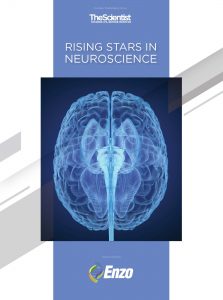Katie was honored to be profiled as 1 of 8 “rising stars in neuroscience” in an eBook from The Scientist, among some truly impressive colleagues.
Here’s the text:
Katherine Thompson-Peer’s curiosity got the best of her when a literature search for neuron regeneration revealed an unappreciated research question: How do dendrites regrow their branches after injury? That curiosity eventually led her to her new lab at the University of California, Irvine, where she uses modern techniques to study this old mystery.
How did you come to study dendrite regeneration?
My graduate work focused on nervous system development, but I wanted to switch it up and study something more clinically relevant. I converted from studying how neurons develop under normal conditions to how they recover after injury. My postdoctoral lab had decades of expertise studying development of dendrite arbors—the highly branched structures that receive information from the environment or neighboring neurons. I was interested in utilizing their experimental tools and insights to study what happens to this arbor after injury.
I started a number of literature searches to learn what was known about neuron recovery. At the time, there were about 1,200 papers on axon regeneration. In contrast, when I searched for dendrite regeneration, there were three hits. I was confused about this disparity because a neuron works as a circuit to process information with both input from dendrites and output from axons.
This seemed to be a blind spot in the field, so I started asking why nobody had studied dendrite regeneration before. My best guess is that it is due to the history of techniques used to study neuroregeneration. Traditionally, this field was built using surgical injury to long bundles of axons. An axon is a bigger target to hit with a scalpel than a dendrite branch.
How do you injure dendrites?
We use an optical injury technique with a two-photon laser microscope to burn the dendrite arbor. We do this in the peripheral nervous system that surrounds the body wall of Drosophila larvae. With the two-photon microscope, we deliver a high-power laser precisely to a small spot. We focus the laser initially at the primary dendrite branch points from the cell body and then repeat this with all of the branches to obtain the strongest effect. Then we follow the same neuron in the larva over many days to see how it recovers.
After injury, the neurons robustly regenerate new dendrites—they grow an arbor with about the same number of branches as uninjured controls1. However, when you take a closer look you see that the regrowth fails to perfectly recreate the uninjured neuron. The arbor is smaller in diameter and how the branches interact with adjacent cells is different. Their touch response is only about 50-60% that of normal neurons. Right now, we’re teasing apart both what allows the dendrites to regenerate as well as they do and what intrinsic cell factors prevent them from fully recreating an uninjured neuron.
What are your main considerations now that you’re starting your own lab?
One of my favorite things is learning who the budding young scientists coming into my lab are—what are their particular strengths and interests, and how can we find projects to match. Science is a long process and you have to enjoy setting up the experiment and troubleshooting, in addition to getting the end result.
A really important aspect of my career has been engaging in outreach and advocacy work to make science more inclusive for people from all backgrounds. I’m highly motivated when thinking about the culture in science and how different populations should be encouraged to become scientists. In my lab, I’m trying to establish a culture where everyone’s voice is valued and everyone is on a level playing field so that we can
all be encouraged to thrive.
What do you hope to accomplish with the dendrite regeneration project?
We are studying this on a cell-by-cell basis right now, but we don’t know the effect for the animal as a whole. My lab is currently piloting techniques to injure many dendrites at the
same time to get more insight into the behavioral consequences. In human tissue surrounding a stroke site, researchers have seen defects in dendrite architecture. It would be good to know how we could improve regeneration after any sort of injury so that the new arbor could function properly as part of its neural circuit.
Generally, I hope to get researchers to think more about the basic science of dendrite regeneration and how that influences how neurons recover. I want to bring more attention to this blind spot in the field. This field is nothing but fundamental open questions ready for big-picture exploration.
Interviewed by Niki Spahich, PhD
